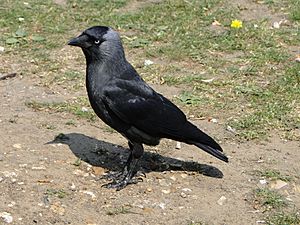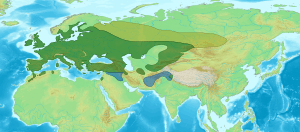Jackdaw facts for kids
Quick facts for kids Jackdaw |
|
|---|---|
 |
|
| Corvus monedula spermologus on Ham Common, London |
|
| Conservation status | |
| Scientific classification | |
| Kingdom: | |
| Class: | |
| Order: | |
| Family: | |
| Genus: | |
| Binomial name | |
| Corvus monedula (Linnaeus, 1758)
|
|
 |
|
| Jackdaw range in green, summer-only range in pale green blue areas are winter visitor only |
|
The jackdaw is a cool, medium-sized bird that belongs to the crow family, called Corvidae. These birds are mostly black, but they have a neat grey patch on the back of their heads.
You can find jackdaws all over Europe and a big part of Asia. Most of them stay in one place all year, but some from colder northern and eastern areas fly south for the winter. Jackdaws are usually about 34–39 centimetres (13–15 in) long.
Jackdaws love to be with other birds. They are very noisy and live in small groups with interesting social rules. You might see them in farms, open forests, on cliffs by the ocean, or even in busy cities.
What Jackdaws Eat
Jackdaws are omnivores, which means they eat both plants and animals. They are also very good at finding food wherever they can! They munch on all sorts of plant bits and small creatures like invertebrates (bugs and worms). In cities, they are happy to eat food scraps that people leave behind.
Jackdaw Life Cycle
Jackdaws are monogamous, meaning a male and female pair up for life. They build simple nests out of sticks inside holes. These holes can be in trees, cliffs, or even buildings.
The female jackdaw usually lays about five eggs. These eggs are a pretty pale blue or blue-green with brown spots. She sits on the eggs to keep them warm until they hatch. The baby jackdaws stay in the nest for about four to five weeks before they are ready to fly.
Jackdaw Social Life
A famous scientist named Konrad Lorenz studied jackdaws a lot. He wrote about how jackdaws interact in his book King Solomon's Ring. He watched a flock of jackdaws that lived around his house in Austria. He even put rings on their legs to tell them apart!
Lorenz discovered that jackdaws have a clear hierarchy, which is like a pecking order. Birds higher up in the order get to do things first, like eat. When a male and female jackdaw pair up, they share the same rank.
Young male jackdaws work to get their own spot in the pecking order before they find a mate. Unmated females are usually at the bottom of the group. They are the last ones to get food or find a safe place to rest. Lorenz once saw a male jackdaw return to the flock after being away. This male quickly became the top bird and chose one of the unpaired females as his mate. As soon as she paired with him, she instantly moved up in the social order and started bossing other birds around! Lorenz realized that all the birds in the flock quickly understood the new pecking order.
Related pages
See also
 In Spanish: Coloeus para niños
In Spanish: Coloeus para niños


